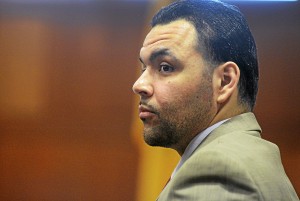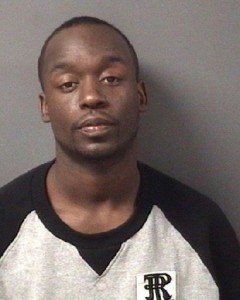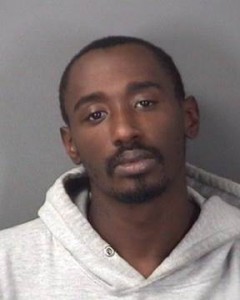
Shaheed Brown listens to testimony from State Police Detective Joseph Itri. Gregg Slaboda - The Trentonian
Enrico Smalley Jr’s brother crumpled on a bench outside of the courtroom, unable to hold back bloodcurdling shrieks that echoed through the hallways of Mercer County criminal court.
That was hours before the second trial of former Newark gang member Shaheed Brown ended in mistrial for the second time in six months.
Smalley’s family spent most of Friday outside of Judge Andrew Smithson’s courtroom, hoping for the best, preparing for the worst and reconciling that they would likely be back here again in a few months after a jury hinted Thursday it was deadlocked.
After they committed to pouring over the evidence one more time, and listening to testimony and watching surveillance tapes again to see if anyone changed their minds, a jury returned to the courtroom Friday around 3:40 p.m. and informed the judge it could not reach a unanimous verdict about whether Brown shot and killed the 20-year-old Ewing man outside of La Guira Bar in the early-morning hours of July 12, 2014.
Prosecutors must decide whether to try the case a third time or offer a new plea deal. (Their last offer, which Brown rejected, called for him to serve 45 years.)
Assistant Prosecutor Brian McCauley, who handled the first two trials, will not be here to try the case again as he is retiring in the summer. Another prosecutor will take over for him, though no new trial date has been set.
Defense attorney Edward Heyburn plans to ask for murder charges to be dismissed.
Both attorneys declined to comment because of a gag order that remains in place.
Smalley’s relatives sat stony-faced inside the courtroom as Judge Andrew Smithson read the jury’s note indicating they were hung. Smithson was the only one that seemed shocked.
“I thought you had a verdict for sure,” he said.
Smalley’s mother, who asked The Trentonian not to use her name, said afterward, “I don’t know what to say. I’m glad they didn’t say, ‘not guilty.’ I can’t be mad.”
While prosecutors and Smalley’s relatives are firmly convinced Brown is the killer, two juries have been firmly unconvinced about the circumstantial case.
There was no murder weapon. No eyewitnesses stepped forward saying Brown pulled the trigger, though eight witnesses took the stand for prosecutors, each provide pieces of an incomplete puzzle.
A shifting motive witnesses testified about obliquely suggested Brown was out for revenge after he was chased from the bar a week earlier by some of Smalley’s gun-toting associates.
But there were obvious holes, and Brown and his defense attorney smartly pointed to them.
Further, Brown’s violent past and apparent ties to the notorious Grape Street Crips in Newark were at odds with the clean-shaven “choir-boy” image he put on at trial. He wore pressed dress pants, shirts and ties and thin-rail spectacles that made him appear regal rather than ruthless.
A teardrop tattoo under his left eye, which on the streets signifies a killer or someone mourning the loss of a loved one, was covered up by women’s concealer.
Also, hardly any concrete ties existed between Brown and Smalley.
Haunting surveillance tapes painted a suspicious picture of Brown with a black glove on his right hand and sagging pants, possibly from a gun, prosecutors suggested. Brown chatted with Smalley while they walked next to each other down the sidewalk around 1:21 a.m.
Moments after they disappeared into the night, another man, Alvie “King” Vereen, stepped off camera while appearing to reach toward his waistband. At that moment, frightened patrons reacted to gunshots on the soundless surveillance tapes.
That’s where Brown’s attorney came in, suggesting Vereen was the killer.
His third-party guilt defense, however, ignored close ties between Brown and Vereen. They were friends, and were arrested together in Newark for an alleged carjacking that happened about a month after Smalley’s death.
The victim, a Trenton man who is believed to have been one of Brown’s associates, refused to press charges against the men in the carjacking.
The jury was unaware of just how tight Brown’s relationship was with Vereen.
Vereen never rolled over on Brown no matter how hard investigators put the screws to him when they interviewed him three times, the first in December 2014, at a detention center in Bucks County, Pa., where he was being held on unrelated drug charges.
Vereen was never called as a witness, and would have likely invoked his Fifth Amendment right against self-incrimination. And Brown never took the stand in either of his two trials.
He is unlikely to take the stand in a third, since doing so would expose him to cross examination about his friendship with Vereen and a baggage-filled past, which includes convictions for attempted murder and aggravated arson – none of which juries were aware.
Knowing all that, Smalley’s mother was angered by the tactics of Brown’s defense attorney, saying it confused the two panels that deliberated the case.
“[Heyburn] blames everyone else,” she said. “They’re probably confused. It’s [Brown] but I don’t know why they’re not seeing it.”
Jurors wouldn’t explain why they couldn’t arrive at a verdict.
They scurried from the courtroom as soon as the judge dismissed them from service. Seven jurors declined separate interviews with The Trentonian, saying they did not wish to speak about the case.
The case seemed destined to end in a mistrial after the jury returned Thursday afternoon saying it could not reach a decision after about five hours of deliberations.
But the jury returned Friday to try to work through their differences after two jurors weren’t convinced the panel was at an impasse. They spent the bulk of Friday morning listening to testimony and watching surveillance tapes a second time.
It didn't help in the end, as the second trial was overcome by juror issues.
Two jurors were dismissed from the case, one over an apparent work conflict and another when she mysteriously failed to show up for deliberations Thursday.
Another woman subbed in. Deliberations started anew when the woman, Juror No. 8, could not be located after court officials called her numerous times.
Fellow jurors told the judge the woman had complained of stomach pain and had her head down at several points during deliberations.















